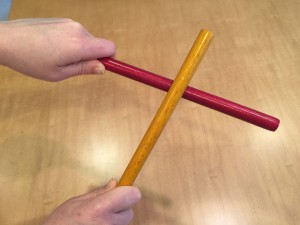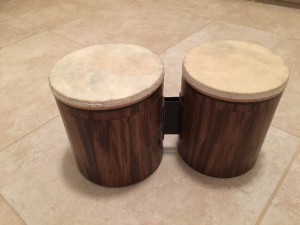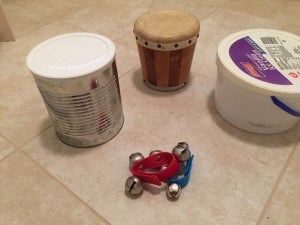 You are humming a tune in your head and unknowingly you start to hum out loud! Oops!
You are humming a tune in your head and unknowingly you start to hum out loud! Oops!
If you are like me, it is a little embarrassing when that happens in public<grin>. That phenomenen of humming something in your head, called AUDIATION, is the ability to know a song so well that you can sing it inside your head without making any sound. Even stronger (and using more brain power) is the ability to sing the words of a song along with the tune and the rhythm. That is what this activity is all about.
Signal
Show the children the signal you will use. I use a small bell, a tone block rhythm instrument, a drum, or some rhythm sticks.
Tell the children that this signal will be our cue to take the song we are singing inside so we are only singing it in our heads and not making any sound. When you give the cue again, that will be the signal to take it out and sing out loud. Tell the children that the tricky thing when we come back in to the out loud singing will be all to be with the right words and the right beat.
Take it in, Take it out
Start singing the song. Give the signal. Sing it inside. Give the signal again. Sing it out loud.
Here are some hints to make this activity successful.
1. Give the signals at the end of a phrase, not in the middle.
2. When the song is inside, show the beat in your body. It silently “conducts” the children so that the whole group stays on the same beat.
3. If you ask a child to give the signal, the activity might break down and be a little chaotic because children tend to give the signal at very awkward points in the song that are very hard for anyone else to follow.
4. Older children can be successful with more rapid signals taking it in and out. Younger children need longer transitions because the skill is only just developing.
I like this activity because it is a challenge for the children (and the adults). I like this activity because it is a great review activity. I like this activity because it gives the children a chance to develop their inner voice… the same voice that manages their impulse control. (What child doesn’t need that?<grin>) I like this activity because it helps the children to truly learn which word comes on which beat and what tone. I like this activity because it is fun!




sunflowerg3
Great idea! Do you have the piano play while doing this (and stop when you take it inside), or is this an a cappella activity?
Sharla Dance
You can have the piano play at first, but ultimately you are trying to have it be a cappella. Thanks for asking.
Holly
Wonderful – as always, you’re inspiring! Can you say more about #2? Are you referring to the leader conducting the beat, having the kids tap the beat, etc.? Thanks!
Sharla Dance
The conductor is motioning with her head, shoulders,… anything that can keep a beat. You can formally conduct, but I found it more effective if it was with your body kind of “dancing” to the music. The younger children will watch you closely!
Lorna Collette
How do you use the instruments?
Sharla Dance
I use one of them for the signal to take it in or take it out.
Laura Bickmore
Thank you! I was wondering about some good Sharla Dance style review! 😀 My junior primary needs work on a couple songs, still!
Kimberly
We did this last week and it was super fun! Once we took the piano away, senior primary was very into it. It was a great couple min filler at the end of singing time.
May – 4 weeks of Primary Music Activity Ideas: Younger | Teaching Primary Music
[…] WEEK 1 – Take it in, Take it out […]
Natalie
I Love this idea! I see how simple, but how powerful the teaching tool is, but how powerful it is if the children grasp the idea. It’s great to develop that inner voice, but it’s also good for a word-review!
Thank you for taking the time to share these ideas!
Sally
I can’t wait to try this! Thank you so much for sharing so many of your ideas and resources. Truly an instrument, you are.
Chantel
What do you use as your signal?
Sharla Dance
I will use a bell, a drum hit, or a chime… something to get the children’s attention but not be too distracting. Thanks for asking!
Pamela Friske
I love this idea Sharla:) Thank you !!!
Saralynn Haralson
When you review a song, which has more than 1 verse, do you review all verses at that time? I seem to loose the kids when I do more than 1 verse, but I find I need to because, by now, we are needing to review multiple songs.
Sharla Dance
Dear Saralynn, When I review 2 or 3 verses together, I often will have them do a different rhythm pattern to each verse to keep challenging them. With older children, you can also do Steady Beat Scramble for one verse, and a paper cup pop pattern (without the cup) to the next. Does that make sense?
Sandy Erickson
Neat idea, I will try it.
Sandy